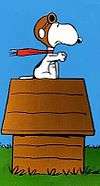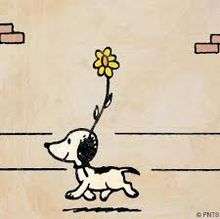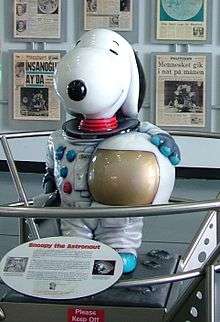Snoopy
| Snoopy | |
|---|---|
| Peanuts character | |
 | |
| First appearance | October 4, 1950 (comic strip) |
| Created by | Charles M. Schulz |
| Voiced by |
|
| Information | |
| Family |
Father: Baxter Mother: Missy Brothers: Spike, Andy, Olaf, Marbles, Rover Sisters: Belle, Molly Owner: Charlie Brown Lila (previously) Clara ("the annoying girl") Peppermint Patty Poochie (possibly before Lila) |
Snoopy is Charlie Brown's pet beagle[3] in the comic strip Peanuts by Charles M. Schulz. He can also be found in all of the Peanuts movies and television specials, like The Peanuts Movie. Since his debut on October 4, 1950, Snoopy has become one of the most recognizable and iconic characters in the comic strip, and is considered more famous than Charlie Brown in other countries. The original drawings of Snoopy were inspired by Spike, one of Schulz's childhood dogs.[4][5]
Traits
Snoopy is a loyal, innocent, imaginative and good-natured beagle who is prone to imagining fantasy lives, including being an author, a college student known as "Joe Cool" and a British World War I "flying ace" in the Royal Flying Corps. He is perhaps best known in this last persona, wearing an aviator's helmet and goggles and a scarf while carrying a swagger stick (like a stereotypical British Army officer of World War I and II).
Snoopy can be selfish, gluttonous, and lazy at times, and occasionally mocks his owner, Charlie Brown, but on the whole he shows great love, care, and loyalty for his owner (even though he cannot even remember his name and always refers to him as "The Round-Headed Kid"). In the 1990s comic strips, he is obsessed with cookies.

All of his fantasies have a similar formula: Snoopy pretends to be something, usually "world famous", and fails. His short "novels" are never published, and his Sopwith Camel is consistently shot down by his imaginary rival enemy, the German flying ace the "Red Baron". Schulz said of Snoopy's character in a 1997 interview: "He has to retreat into his fanciful world in order to survive. Otherwise, he leads kind of a dull, miserable life. I don't envy dogs the lives they have to live."[6]
Snoopy imagines himself to speak, but never actually does, other than moans and yipping yelps and sniveling crying; the human characters are unaware of his intellectual musings. Very rarely, he talks, but usually to himself. His (very articulate) thoughts are shown in thought balloons. In the animated Peanuts films and television specials, Snoopy's thoughts are not verbalized; his moods are instead conveyed through moans, yelps, growls, sobs, laughter, and monosyllabic utterances such as "bleah" or "hey" as well as through pantomime. His vocal effects were usually provided by Bill Melendez, who first played the role during Snoopy's appearances on The Tennessee Ernie Ford Show.[7] The only exceptions are in the animated adaptions of the musicals You're a Good Man, Charlie Brown and Snoopy!!! The Musical in which Snoopy's thoughts are verbalized by Robert Towers and Cameron Clarke, respectively. (His dialogue, however, is not "heard" by the other characters except Woodstock the bird and other non-human characters.)
Snoopy's doghouse defies physics and is shown to be bigger on the inside than the outside. It is usually shown in a side view, so you cannot see the inside, except for the May 8, 1960 comic strip in the second frame.
History

Snoopy appeared on the October 4, 1950, strip, two days after the first strip. He was called Snoopy for the first time a month later, on November 10. On March 16, 1952,[8] his thoughts were first shown in a thought balloon. Snoopy first appeared upright on his hind legs on January 9, 1956, when he was shown ice-skating across a frozen lake.[9]
Relationship with other Peanuts characters
Charlie Brown
Despite his history of conflicted loyalties, his constant disrespect for Charlie Brown, and his inability to remember his name (he refers to him as "that round-headed kid"), Snoopy has shown both love and loyalty to his owner. He joins Charlie Brown in walking out of a game of Ha-Ha Herman when Peppermint Patty insults Charlie Brown, unaware that Charlie Brown is within earshot.[10] He also helps Charlie Brown recover his autographed baseball when a bully takes it and challenges Charlie Brown to fight him for it. When Charlie Brown has to stop dedicating himself to making Snoopy happy, Snoopy replies, "Don't worry about it. I was already happy." In The Peanuts Movie, Snoopy remains loyal to Charlie Brown, supporting and caring for him throughout the movie.
In early Peanuts strips, Charlie Brown was not Snoopy's owner (as seen in the February 2, 1951, strip), and it was initially not clear who his owner actually was. The September 29, 1951 strip implied that Snoopy was owned by Shermy. Charlie Brown was first portrayed as being responsible for Snoopy in the strips of November 1 and 3, 1955; it was not until September 1, 1958 that Snoopy was specifically said to be Charlie Brown's dog. (In the September 20, 1980 strip, Charlie Brown comments that he once told Snoopy to "stay" and "he never went home.")
Lucy
Snoopy frequently tries to kiss Lucy on the cheek and/or nose, which Lucy, who is afraid of dog germs, thoroughly hates. These actions occasionally result in Lucy hurting Snoopy. Despite their rivalry toward each other, each seems to care for the other: in Snoopy, Come Home, Lucy is sad to see him go and is (momentarily) glad when he comes back home. In some strips, Lucy goes to Snoopy for help, such as in the April 16, 1961[11] strip, wherein a jealous Lucy and Frieda are beating each other up at Schroeder's piano, Lucy ends up winning, and shakes hands with Snoopy in the end, looking slightly injured. Snoopy also commandeers Lucy's psychiatric booth either in her absence or when she ends up being the one needing help.
Linus
Snoopy often tries to steal Linus' blanket, leading to slapstick fights and wild chases in which Snoopy often wins.
Lila
Lila was Snoopy's owner before Charlie Brown. Snoopy visits her in the film Snoopy, Come Home and struggles to decide whether to stay with Charlie Brown or go back to Lila. Lila eventually convinces him to leave Charlie Brown so he can live with her again. However, upon arriving at her residence, Snoopy is overjoyed to see a "NO DOGS ALLOWED" sign, and returns to live with Charlie Brown.
Peppermint Patty
Peppermint Patty often refers to Snoopy as a "funny looking kid with a big nose", unaware that he is a beagle. In one instance, she has him serve as her attorney in a case involving the school dress code. In the March 21, 1974, strip, Marcie tells Peppermint Patty that Snoopy is a beagle, finally resulting in her realizing his true identity. Snoopy serves as Peppermint Patty's watchdog several times. She is one of the few girls who does not get disgusted after being kissed by him.
Sally Brown
Like Lucy, Sally does not care that much for Snoopy and often calls him a stupid beagle. Sally usually complains when her big brother asks her to feed Snoopy whenever he is away from home. While she is still an infant, Sally has a friendly and playful relationship with Snoopy. In later years, Sally occasionally enlists Snoopy's help in school assignments. She even treats him to an ice cream cone (a very tall ice cream cone, with scoops of about a dozen flavors) when Snoopy helps her get an "A" on a report about "Our Animal Friends". In one story line, Sally uses Snoopy as a "weapon" to help protect her from bullies on the playground (Snoopy barks loudly at anyone who threatens Sally, leading Snoopy to comment, "I feel like a can of mace!"), but this ends in disaster when Snoopy sees an old girlfriend of his and runs off to meet her, abandoning Sally and leaving her to get "slaughtered" by the playground bullies.
Schroeder
Schroeder does not mind much when Snoopy sits against his toy piano, except when Snoopy dances on top of the piano, much to Schroeder's annoyance. He also sometimes plays with the notes coming from the piano.
Rerun van Pelt
Rerun, the youngest child character in the strip, plays with Snoopy sometimes. In some strips, Rerun and Snoopy are playing cards with each other, both of them clueless on how to play.
Siblings
Snoopy is usually depicted as having seven siblings, five of whom appear at some point in the strip: Andy, Belle, Marbles, Olaf, and Spike. They were born at the Daisy Hill Puppy Farm. Most often seen is Spike, who lives a hermit-like existence in the desert, near the real-life location of Needles, California.
Woodstock
Woodstock is Snoopy's best friend and sidekick. He is a small, yellow bird of indeterminate species. He speaks in a chirping language that only Snoopy and his other bird friends can understand. In return, the birds somehow understand Snoopy's thoughts. In some strips, Snoopy can be seen telling a joke to Woodstock and both laugh so hard they end up falling off the doghouse. Woodstock sometimes sleeps on top of Snoopy's nose, such as in one strip where Snoopy says "Never share your pad with a restless bird".
Fifi
Fifi is a major love interest of Snoopy and she appears in Life Is a Circus, Charlie Brown and The Peanuts Movie. In Life Is a Circus, Charlie Brown, Snoopy sees Fifi at a circus and starts to get attracted to her. He and Fifi do a trapeze act and afterward, he runs away, taking Fifi with him. Fifi decides to go back to the circus, however, leaving Snoopy heartbroken and forced to return to Charlie Brown. In The Peanuts Movie, Fifi (voiced by Kristin Chenoweth) is a pilot just like Snoopy, and together they have an interaction via Snoopy's typewriter against the Red Baron. He shows how much he cares for her when he cries at Schroeder's house after she is captured by the Red Baron. Snoopy, Woodstock, and the Beagle Scouts set out on a mission to rescue her. Eventually, they save her, and she shows her affection to Snoopy.
Reception
Snoopy and Charlie Brown were ranked by TV Guide as the 8th greatest cartoon characters of all time.[12]
Some critics feel that the strip suffered a decline in quality after the 1960s. Writing in 2000, Christopher Caldwell argued that the character of Snoopy, and the strip's increased focus on him in the 1970s, "went from being the strip's besetting artistic weakness to ruining it altogether". Caldwell felt that Snoopy "was never a full participant in the tangle of relationships that drove Peanuts in its Golden Age", as he could not talk. He went on to say that Snoopy "was way too shallow for the strip as it developed in the 1960s, and the strips he featured in were anomalies."[13]
Awards and honors
Schulz was a keen bridge player, and Peanuts occasionally included bridge references. In 1997, according to Alan Truscott, the American Contract Bridge League (ACBL), awarded both Snoopy and Woodstock the honorary rank of Life Master, and Schulz was delighted.[14] According to the ACBL, only Snoopy was awarded the honor.[15]
On November 2, 2015, Snoopy was honored with a star on the Hollywood Walk of Fame, becoming the second Peanuts-related figure to be inducted with a star, after Schulz.[16]
In aviation and space

- Following the Apollo 1 fire, Snoopy became the official mascot of aerospace safety, testing and the rebuilding of the Apollo Program.
- The Apollo 10 lunar module was named Snoopy and the command module Charlie Brown. While not included in the official mission logo, Charlie Brown and Snoopy became semi-official mascots for the mission, as seen here and here. Schulz also drew some special mission-related artwork for NASA, and several regular strips related to the mission, one showing Snoopy en route to the moon atop his doghouse with a fishbowl on his head for a helmet. "We have mentioned," wrote television producer Lee Mendelson, "that Charles Schulz is a gambler, a man who doesn't sit pat on success. The New York Times headlined: 'Creator of Peanuts Tempts Fate on Apollo Mission.' Certainly, if a tragedy had occurred, as well it might have, the symbols would forever remain in man's mind as symbols of disaster. But Sparky has always had faith in the Apollo program, from the very start, and he felt if those men could risk their lives, the least he could do would be to risk the popularity of the characters."[17][18] The strip that ran on July 21, 1969 – one day after the Apollo 11 lunar module Eagle landed on the moon – included a full moon in the background, with a black mark on it representing the module.[19]
- The fabric cap worn by NASA astronauts as part of the Extravehicular Mobility Unit is known as a "Snoopy cap", a reference to how the white crown and black earflaps of the cap resemble Snoopy's fur and ears.
- The Silver Snoopy award is a special NASA honor, in the form of a sterling silver pin with an engraving of Snoopy in a spacesuit helmet. It is given by an astronaut to someone who works in the space program that has gone above and beyond in pursuit of quality and safety.[20]
- Snoopy is the name of a United States Air Force B-58 Hustler bomber, serial number 55-0665, which was modified to test a radar system.[21]
- American insurance company MetLife used Snoopy as their corporate mascot between 1985 and 2016. Snoopy One, Snoopy Two, and Snoopy J are three airships owned and operated by MetLife that provide aerial coverage of sporting events, and feature Snoopy as the World War I flying ace on their fuselage. As of October 20, 2016, MetLife no longer features Snoopy in its commercials, due to a global rebranding.[22][23]
- The Charles M. Schulz–Sonoma County Airport in California, named after Schulz, has a logo featuring Snoopy in his World War I flying ace attire flying atop his doghouse.
- Snoopy is the mascot of the 26th Squadron (Barons, pronounced Barones) of the United States Air Force Academy, appearing on their squadron patch.
References
- ↑ "Bill Melendez at Moby Games". Retrieved 2017-10-25.
- ↑ "Gerald Paradies at Moby Games". Retrieved 2017-10-29.
- ↑ "World's Most Famous Beagle", The Victoria Advocate, Victoria, Texas, p. 54, 15 December 1974, retrieved 20 November 2017
- ↑ Schulz, Charles M. (1994). Around the world in 50 years: Charlie Brown's anniversary celebration. Andrews McMeel Publishing. p. 11. ISBN 978-0-8362-1766-7.
- ↑ Snoopy, Charlie Brown et les autres. L'album de famille de Schulz. ISBN 978-2-7324-2681-5.
- ↑ Groth, Gary (December 1997). "Charles Schulz at 3 o'clock in the morning". The Comics Journal: 27 (flip).
- ↑ Barrier, Michael (October 1989). ""He's a howling success at bringing comics to life"". Nation's Business. Washington D.C.: Chamber of Commerce of the United States. Retrieved July 18, 2018.
- ↑ "Peanuts". March 16, 1952.
- ↑ Schultz, Charles M. (2009). Celebrating Peanuts: 60 Years. Andrew McMeel Publishing. p. 4. ISBN 978-0-7407-8548-1.
- ↑ Schulz, Charles. "Peanuts by Charles Schulz, October 09, 1971 Via @GoComics".
- ↑ Schulz, Charles. "Peanuts by Charles Schulz, April 16, 1961 Via @GoComics". GoComics. Retrieved 2016-05-31.
- ↑ "TV Guide's 50 Greatest Cartoon Characters". 30 July 2002. Retrieved 2013-09-17.
- ↑ Caldwell, Christopher (January 4, 2000). "Against Snoopy". New York Press.
- ↑ Truscott, Alan (July 10, 2000). "BRIDGE; Snoopy's Finest Card Game (Trump That, Red Baron!)". New York Times. Retrieved July 16, 2016.
- ↑ "Who Plays Bridge". ACBL. Retrieved July 18, 2016.
- ↑ "Wow! Snoopy Receives A Star On Hollywood Walk Of Fame". FilmiBeat. November 3, 2015.
- ↑ Mendelson, Lee (in association with Charles M. Schulz), Charlie Brown & Charlie Schulz, Signet Books, 1971, pp. 239-240.
- ↑ Roberts, Steven V., "You're a Brave Man, Charlie Brown," New York Times, May 26, 1969, p.20.
- ↑ "Peanuts Comic Strip, July 21, 1969 on GoComics.com". gocomics.com. Retrieved 2015-09-05.
- ↑ "Space Flight Awareness Awards: SFA Silver Snoopy". Space Flight Awareness, NASA website. National Aeronautics and Space Administration. Archived from the original on February 28, 2007. Retrieved 2007-06-21.
- ↑ "B-52s in the Desert". check-six.com. Retrieved 2015-09-05.
- ↑ Airship Operations information for MetLife blimp Archived May 13, 2008, at the Wayback Machine.
- ↑ Hauser, Christine; Maheshwari, Sapna (2016-10-20). "MetLife Grounds Snoopy. Curse You, Red Baron!". New York Times. Retrieved 2016-10-20.
External links


- The complete text of Snoopy's It Was a Dark and Stormy Night